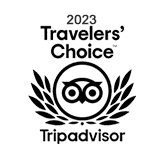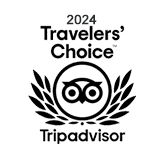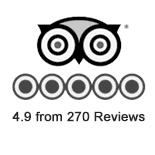SURF TECHNIQUE: THE POP UP

SURF TECHNIQUE: THE POP UP Here is a “how to surf” tutorial on various surfing techniques which are vital when you are learning how to surf. It is not meant as a replacement for going on a learn to surf holiday (like those we offer at Swell) but rather as a reference with visuals to make learning easier. About Swell Surf Camp We offer luxury surf holiday experiences for people who want to learn how to surf in warm, Caribbean water. We focus on a structured approach in our surf lessons, taught by ISA qualified surfing instructors. Read more about the surf holidays we offer >>
HOW TO SURF: THE POP UP
- Place hands flat on your board under your chest (see note below about hand-position)
- Push up: Arch your back, weight on toes and hands
- Twist your hips into a position which allows you to first move your back* foot into position
- Move front* foot into position, place front foot between your hands
- Stand up, keeping center of gravity low with your kness bend & looking forward
*your ‘back’ or ‘front’ foot is determined by whether you are ‘regular/natural-footed’ (that’s riding with the left foot forward) or ‘goofy-footed'(riding with your right foot forward).
In order to test this, have someone push you gently from behind on a flat surface (ideally when you are not expecting it). The foot which leads the step determines if you are natural/regular or goofy. If you have skateboarded or snowboarded, with surfing, you are very likely to ride with the same foot forward.
More info on the correct surf stance here >>
SURFING TECHNIQUE: TAKING OFF

There are various ways how to do a successful pop-up on a surfboard, below is the approach we use the most at Swell in our surf lessons at Playa Encuentro.
This approach to the pop-up is only suitable for beginners learning how to surf on big surfboards (anything over 8′ and ideally on a soft top with plenty of volume and stability). Depending on how tall you are, you might adjust your hand position further under your ribcage (imagine a pendulum) to give your feet the space to move.
For best results, this technique is best practised first on the beach, so you have extra stability, then when you have mastered it on the beach, practice in small mellow waves, like those we have at Playa Encuentro. The following images show the pop-up technique for a surfer with a “natural/regular” stance (riding with left foot forward), If you are a goofy-footer (right foot forward), the technique stays the same, just move the other foot as opposed to how it’s shown in these images.
WHERE TO PRACTICE THE POP-UP SURFING TECHNIQUE
Practise on the beach, then go out on small ‘white water’ waves. White water of about 30 to 50 cm is ideal.
Enough power to give you forward thrust.
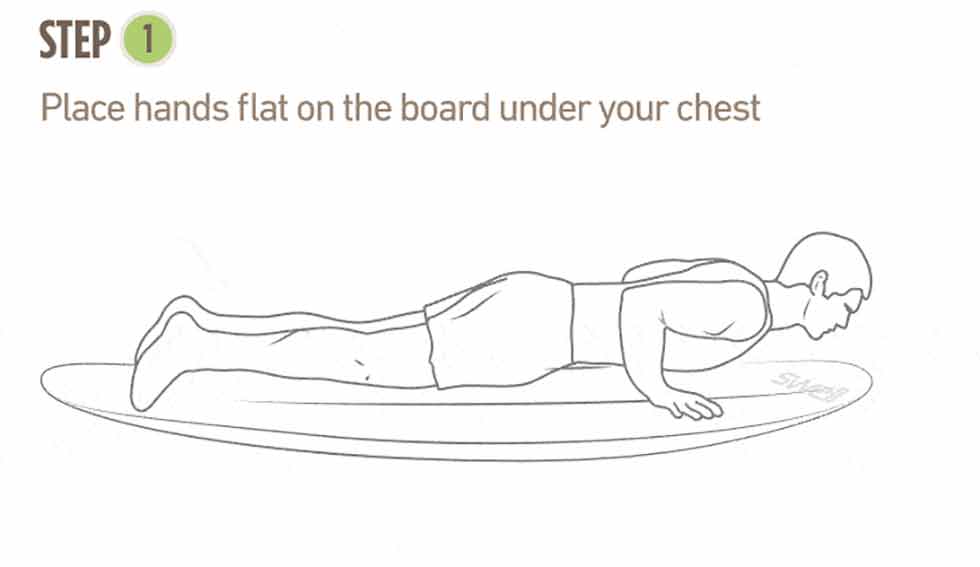
Paddle hard enough to catch the wave and feel the force of the wave pushing you forward.
As you gain speed the board gets a bit more stable. Now place both hands flat on your surfboard under your chest (don’t grab the rail of the surfboard). Some taller people find it easier to place their hands further down the chest towards the ribcage to ‘balance’ their body before moving the feet.
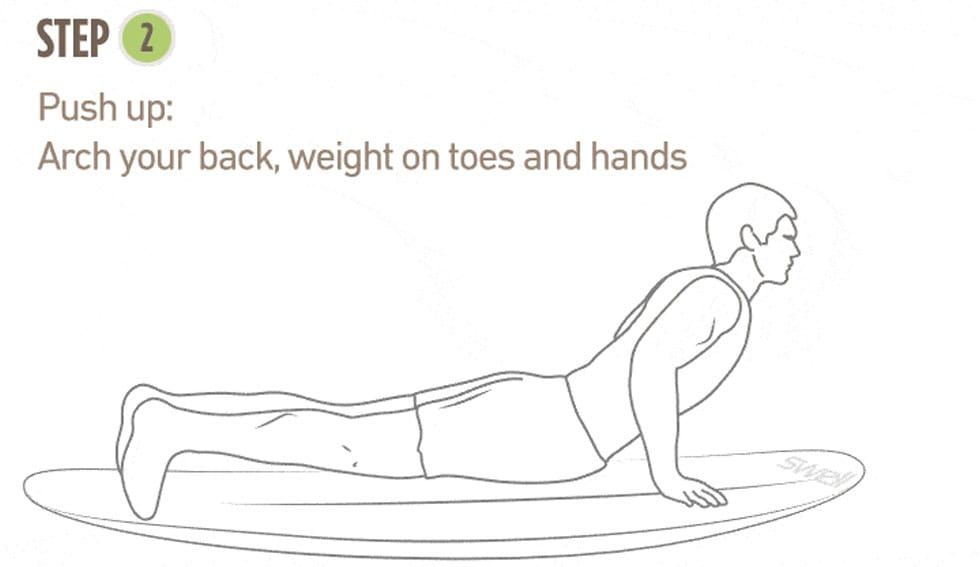
Now arch your lower back – by doing a push-up movement.
Only your toes/feet and hands should be touching the board, look up / forward, not down at your board.
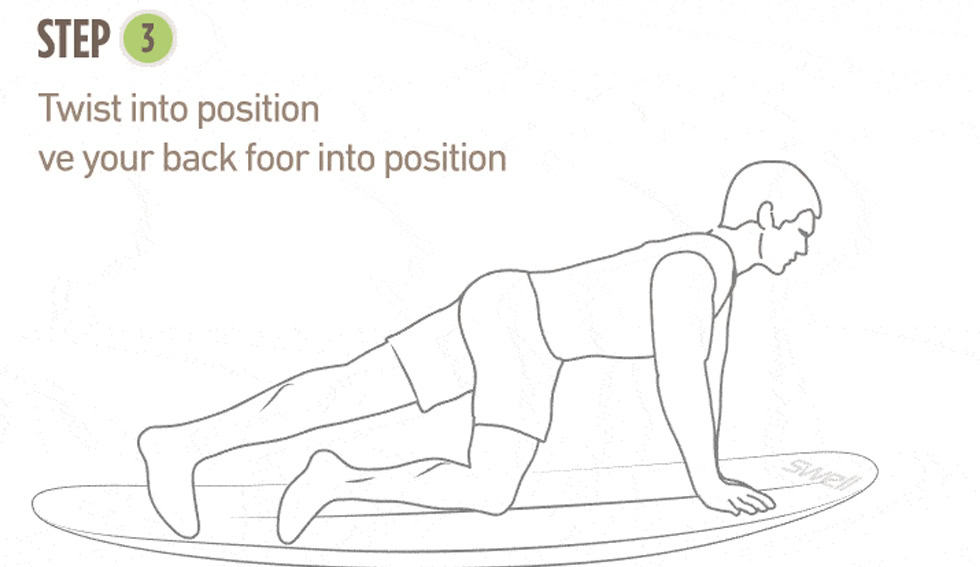
Now slide your ‘back’ foot into position first (it sounds confusing, but this will be your left foot if you are goofy and your right foot if you are a natural-footed surfer).
The back foot should move about 35-45 cm forward. Twisting your body will make this easier as it creates space.
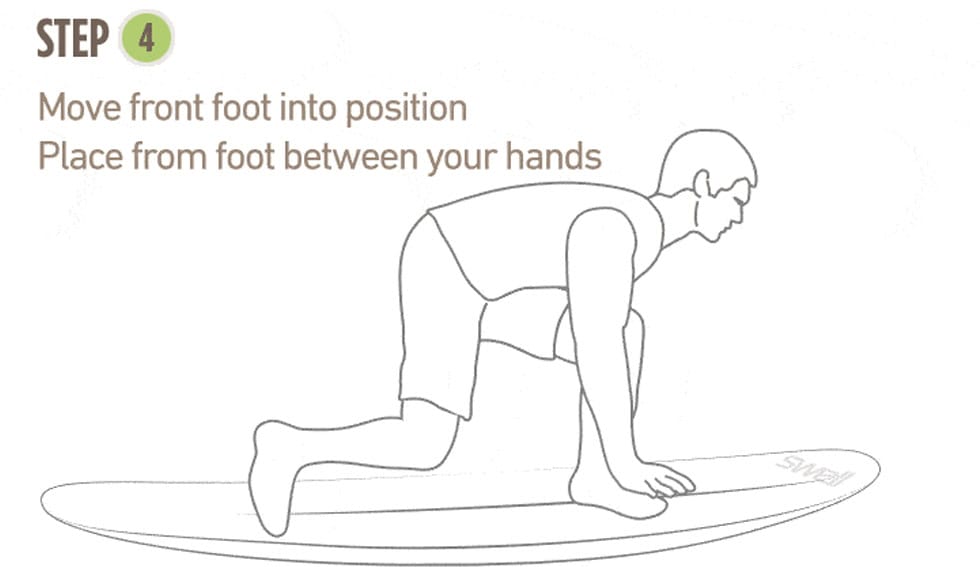
Then move your front foot towards your hands staying very low to maintain balance.
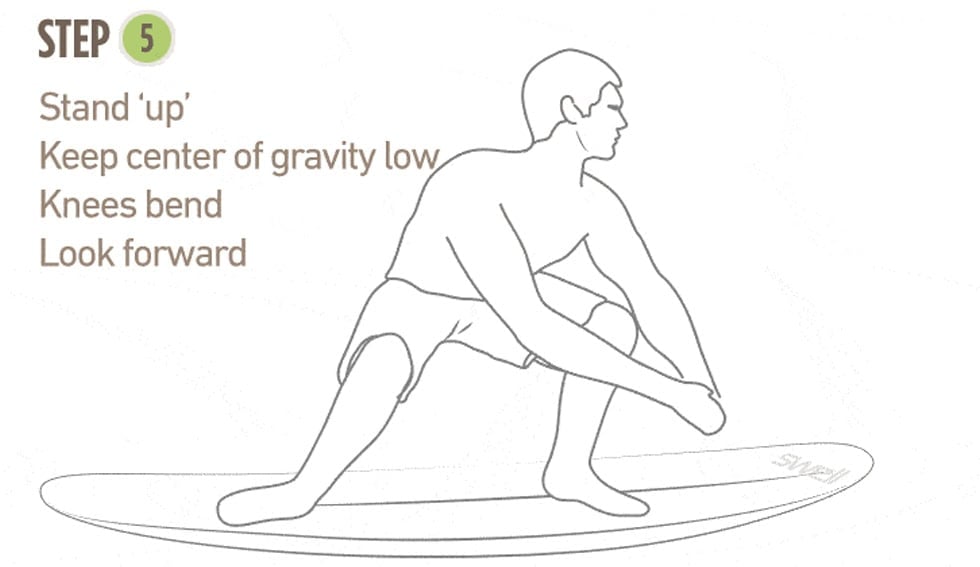
In the final part of the pop-up, release your hands from the board but make sure to keep a low centre of gravity ( = better balance) by bending both knees; you can also extend your arms straight, one forward and one behind you to further increase your balance.
Look forward (not down!) and enjoy the glide!
SURFING POP-UP TECHNIQUE / VIDEO
COMMON MISTAKES WHEN PRACTISING THE POP UP
![]() Practise on the wrong waves: the pop up technique should be practised in small white water waves, not out in the lineup (out the back) for first-time surfers. Don’t go out in big waves, or crowded surf spots.
Practise on the wrong waves: the pop up technique should be practised in small white water waves, not out in the lineup (out the back) for first-time surfers. Don’t go out in big waves, or crowded surf spots.
![]() Feet in the wrong position: Your feet should be pretty much in the centre of the board, over stringer (centre line made of wood in the board)
Feet in the wrong position: Your feet should be pretty much in the centre of the board, over stringer (centre line made of wood in the board)
![]() Wrong hand position: Don’t grab the rails of the surfboard, it will slow the board down and will also make the board a lot more unstable for the push-up
Wrong hand position: Don’t grab the rails of the surfboard, it will slow the board down and will also make the board a lot more unstable for the push-up
![]() Knees on the board. A lot of beginners do this, it might make standing up on your first waves ‘easier’ but it’s a bad technique and correcting it later takes more time, so skip the knees on the board part.
Knees on the board. A lot of beginners do this, it might make standing up on your first waves ‘easier’ but it’s a bad technique and correcting it later takes more time, so skip the knees on the board part.
![]() Looking down: A very common mistake in people learning how to surf is to look and see what they are doing, so looking down at their feet / board / water. It make keeping your balance very difficult and you cannot see where you are going. Keep looking forward!
Looking down: A very common mistake in people learning how to surf is to look and see what they are doing, so looking down at their feet / board / water. It make keeping your balance very difficult and you cannot see where you are going. Keep looking forward!
![]() Too early: Don’t stand up too early. Make sure the wave is properly giving you forward momentum. Stand up too early, and the board will lose speed, you miss the wave and will fall off.
Too early: Don’t stand up too early. Make sure the wave is properly giving you forward momentum. Stand up too early, and the board will lose speed, you miss the wave and will fall off.
![]() Standing too upright. You have done all this hard work to stand on the board and now you want to stand tall! Don’t do it! By staying low and bending the knees you have a lot more stability.
Standing too upright. You have done all this hard work to stand on the board and now you want to stand tall! Don’t do it! By staying low and bending the knees you have a lot more stability.
![]() Leaning over with upper body. All the bend should be in the knees, not the upper body. When you bend/lean over with your upper body, keeping your balance is practically impossible and you will fall.
Leaning over with upper body. All the bend should be in the knees, not the upper body. When you bend/lean over with your upper body, keeping your balance is practically impossible and you will fall.
Tips ![]() Use a big soft top surfboard. Sure those little boards look cool, but learning on a board that is too small will make learning to surf far harder and will take you forever. Big soft tops are stable and safe.
Use a big soft top surfboard. Sure those little boards look cool, but learning on a board that is too small will make learning to surf far harder and will take you forever. Big soft tops are stable and safe.
![]() Practise on the beach. Before going out in the water, practise 15-20 pop ups on the sand.
Practise on the beach. Before going out in the water, practise 15-20 pop ups on the sand.
Watch other surfers. See how they do it. ![]()
Ask for feedback. Ask your surf instructor for tips. ![]()
Stay positive. As easy as some surfers make it look, learning to surf is not easy! Don’t get discouraged when you make mistakes, we were all beginners once. Once you have mastered the surfing pop up on a longboard you can start trying the technique on smaller boards.
SIMULATING WAVE CONDITIONS
To make your practice even more effective, try simulating wave conditions:
- Use a balance board or a Bosu ball to mimic the instability of a surfboard on water.
- Practice your pop up on these unstable surfaces to improve your balance and coordination.
- This will help you get used to the feeling of popping up on a moving wave.
By incorporating these dry land drills into your routine, you’ll be well on your way to mastering your surfing pop up!
The video below shows how the top pros do their pop up in slow motion on a shortboard at the Surf Ranch.
HOW TO SURF: THE POP UP
Here is another good instructional video of the do’s and don’t to mastering the pop up surf technique
SURF TECHNIQUE POP UP VIDEO
TIPS FOR A BETTER SURFING POP UP
The following tips will take your surfing pop-up to the next level and keep you eager for more waves.
The Right Surfboard
Choosing an appropriate surfboard is key to achieving a successful pop-up. For those just starting, it’s often suggested to use longboards because their larger size enables your feet to remain on the tail of the board, simplifying the process of standing up.
Conversely, shortboards offer more difficulty as they necessitate your feet to extend off the tail, demanding extra exertion during the pop-up process. To simplify this choice for those just starting, models such as Mr Whippy and Big Squid are excellent options.
These boards make the learning process more manageable and ensure that new surfers can get the hang of popping up effectively without being hindered by equipment unreliable for their skill level or physical capabilities—transitioning effectively into surf training will be a far smoother experience with these fundamental elements established.

Effective Surf Training
Effective surf training focuses on building the necessary strength and skills for a better pop-up. Practising pop-ups on the floor can greatly improve muscle memory and arm strength.
This type of exercise mimics an explosive push-up, which is crucial for popping up swiftly on your board in the water. It’s like preparing your body ahead of time for what it will need to do once you’re surfing.
For those looking to perfect their technique, following a specialized program such as the “Fix Your Pop Up Program” can offer detailed assessments and personalized strength training plans.
This approach ensures that each surfer works on specific areas needing improvement, leading to more effective results in their pop-up performance.
Correct Take-off Angles
Mastering the right take-off angles can determine whether you smoothly catch a wave or end up tumbling in the white water. Position yourself at the back of your board to effectively use the wave’s energy for popping up.
This situation helps you lift yourself with less effort as you prepare to stand. But be mindful, that too much weight on the front might accelerate things at first but could lead to nose-plunging into the water Conversely, keeping more weight at the back improves control and stability during manoeuvres but may reduce your pace.
Keeping your weight balanced in the centre of the board is crucial during paddling to maintain good speed and manoeuvrability. This equilibrium enables you to paddle effectively while positioning yourself ideally for catching waves with optimal momentum.
Following this, we’ll explore the topic of finding your stance on the surfboard.
Finding Your Stance
Discovering whether you’re a goofy or regular-footer is crucial for a solid pop-up. If your right foot naturally falls to the back of the board near the tail, with your left foot leading near the centre, you’re surfing with a regular stance.
On the flip side, if it feels more comfortable to have your left foot at the back and your right foot forward, then goofy is your go-to stance. This isn’t just about what feels natural; it’s about setting up for balance and control on waves.

Your feet should stand shoulder-width apart once you’ve popped up. This setup isn’t random—it’s essential for shifting weight effectively to keep the surfboard flat and responsive underfoot.
Stance plays a big role in how well you navigate the surf, turning theoretical knowledge into practical skill as soon as you hit the water.
Proper Hand Placement
After finding your stance, focusing on proper hand placement becomes crucial. Place your hands flat on the surfboard at ribcage level, making sure they are spaced about board width apart.
This position provides stability and control as you prepare to pop up. Keeping your hands correctly aligned helps in generating the necessary force for a swift and balanced lift off the board.
Transition smoothly into a standing position by bringing your front foot under your body right to where your hands were placed, without letting your knees touch the board. Make sure both feet leave the board simultaneously and land back down in one fluid motion.
This technique ensures a solid base for balancing in a low, bent-knee stance with arms outstretched for balance while keeping your gaze forward, ready to ride the wave ahead.
Using Visualization Techniques
Once you’ve mastered proper hand placement, turning your attention to visualization techniques can further enhance your surfing pop up. Visualization is like a secret power that helps you see and feel each move before hitting the waves.
Picture yourself paddling into the wave, popping up smoothly, and riding with perfect balance. This mental practice guides your body through the motions even when you’re not in the water.
It’s all about focusing on where you want to go and seeing yourself succeed in achieving that perfect stance with your knees bent for stellar balance.
Practising visualization also means improving your wave reading skills without getting wet. Imagine analyzing a wave’s shape, speed, and direction, then visualize timing your pop-up flawlessly.
This technique isn’t just daydreaming; it’s an effective way to cement muscle memory and boost confidence on real waves. Every successful ride begins in your mind’s eye – by vividly conjuring every detail of a well-executed pop-up, you prime yourself for actual success out in the surf.
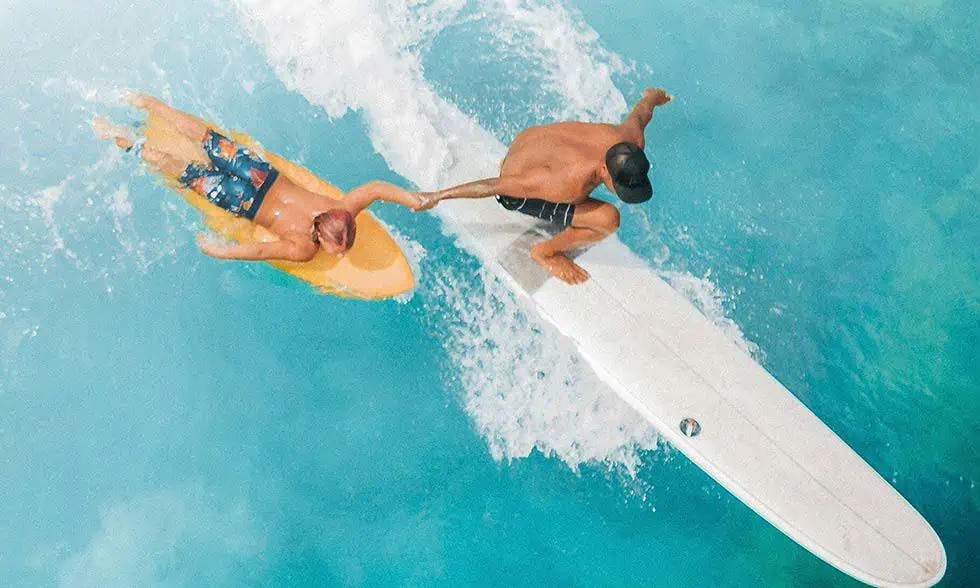
Importance of Surf Skating
Surf skating significantly boosts movement flexibility and technique mastery, which are fundamental for executing an efficient pop-up in surfing. It reproduces the actions and demands of surfing on solid ground, offering a convenient means to hone pop-up skills outside of the water.
This technique strengthens confidence and muscle memory, setting surfers up for authentic wave scenarios. By paying attention to this part of the training, surfers can increase their nimbleness and reaction speed in the water.
Including surf skating in habitual training paves the way for a personal evaluation of physical constraints while actively striving to augment strength and flexibility. Establishing a persistent practice routine with surf skating can immensely strengthen one’s potential to become adept at the surf pop-up.
This strategy assists in conquering technical obstacles, and it significantly contributes to understanding wave patterns through amplified balance and stance modifications.
FREQUENTLY ASKED QUESTIONS
Why is the pop-up so important in surfing?
The pop-up is crucial because it sets the foundation for your entire ride. A smooth and quick pop-up helps you maintain balance and control, making it easier to catch and ride waves.
How can I practice my pop up at home?
You can practice your pop-up at home by using a strip of tape on the floor to simulate your surfboard. Perform the pop-up motion repeatedly, ensuring your feet land correctly on the tape each time.
What are common mistakes to avoid during the pop-up?
Common mistakes include using your knees to help you stand, incorrect foot placement, and rushing the popup. Avoiding these errors will help you improve your technique and ride waves more effectively.
I’m having trouble with my balance during a surf pop-up; any advice?
Ah, the classic wobble! It’s common to struggle with balance in the beginning. Try widening your stance or shifting your weight more towards the center of the board – you’ll be popping up like a pro in no time!
Are there specific exercises that can help me master a better surfing pop up?
Absolutely! Strength training exercises targeting core muscles can be beneficial since these are crucial for maintaining balance during a surf pop-up. Yoga poses such as plank or downward dog can also help.
How important is timing when doing a surf pop-up?
Timing is everything in surfing! If you’re too early or late with your popup, catching that wave might remain just a dream instead of becoming an exhilarating reality.
 We hope we made it as clear as possible for you. But feel free to send us a message if something is not clear, or if you want to join us in the Caribbean for a learn how to surf holiday, where our qualified surfing instructors teach you the above steps, and will help you with any questions you might have.
We hope we made it as clear as possible for you. But feel free to send us a message if something is not clear, or if you want to join us in the Caribbean for a learn how to surf holiday, where our qualified surfing instructors teach you the above steps, and will help you with any questions you might have.
ABOUT SWELL SURF CAMP
Located on the scenic north coast of the Dominican Republic is our purpose-built surf resort
We cater for surfers of all levels, from beginners to expert surfers who are looking for an active surf holiday
Swell offers full surf package holidays
-
WHERE IS SWELL LOCATED?
Swell Surf camp is located on the North coast of the Dominican Republic, right in the center of the cool surfer town of Cabarete. With 3 international airports to choose from it's also one of the easiest places to get to for a quick surf getaway. Puerto Plata Airport is only 25 minutes away from Swell. On the' getting here' page you'll find the different options of getting to us.
-
ABOUT SWELL SURF CAMP
Founded in the winter of 2009, Swell Surf Camp emerged from Jeroen and Clare Mutsaars vision. They lived in the Dominican Republic for eight years and spotted a gap in the surf camp market for higher quality accommodations combined with an engaging social atmosphere. Their extensive travel and stay experiences across different countries like Costa Rica, Nicaragua, Peru, Hawaii, Indonesia and various European nations fueled their passion to elevate the surfing retreat experience.
Swell Surf Camp is renowned as the world’s first luxury surf camp tailored specifically for beginners. The founders collaborated with a notable Swiss architect to design facilities that blend comfort with style. This innovative approach ensures every guest enjoys superior lodging and amenities. Since its inception, Swell has taught over 9,000 people how to surf with an emphasis on safety, fun, and structure.
Our achievements speak volumes. Swell has collected numerous accolades and maintains hundreds of stellar reviews from guests globally. Recognized repeatedly as the leading destination for luxury surf vacations, our commitment to excellence keeps us at the forefront of the industry.
Beyond surfing, Swell offers a diverse range of activities including kitesurfing, wingfoiling, and yoga classes. Guests can also enjoy horse riding both on scenic beaches and mountain trails—plus exciting adventure-filled excursions like canyoning.
A crucial element of any vacation is food, and here at Swell we excel. We provide delicious home-cooked meals daily. For evenings out, guests find themselves just minutes away from an array of dining options that promise satisfying culinary adventures.
For those who prioritize upscale amenities and wellness in a unique setting built around learning surf skills amid profound natural beauty, Swell should be on the top of your surf destination list
-
WHAT SPORTS DOES SWELL OFFER?
It's not only surfing that's on offer at Swell, we also offer learn to wingfoil and learn to kitesurf packages.
-
WHAT TO EXPECT FROM A 1 WEEK LEARN TO SURF HOLIDAY
Dreaming of catching your first wave but wondering if surf lessons are really for you? At Swell Surf Camp, our lessons are designed specifically for beginners, and we mean absolute beginners, particularly those between 40 and 55 from cities like New York, Boston, or Toronto. You’ll never feel rushed, lost, or out of place. Our expert instructors genuinely love teaching, and their approach is as much about encouragement as it is about skill-building. Every instructor carefully tunes each lesson to fit one person, you, so you always get personalized support, whether you’re working on basic paddling, learning to pop up, or building confidence in the water.
The journey at Swell Surf Camp is about progression, not perfection. You’ll start with the very basics, practicing on the sand before moving into gentle ocean waves with your instructor right beside you. Throughout every lesson, our focus is on clear communication, safety, and keeping things fun. As you progress, our instructors give you feedback in real-time, helping you celebrate small wins and guiding your next steps. You’ll learn solid surfing foundations, water safety, and even the unwritten rules of surf culture. By the end of your stay, you’ll be amazed at your own growth and how natural surfing feels. Don’t wait to discover how transformative a single lesson can be, book your surf adventure at Swell Surf Camp and let your surfing journey begin!

